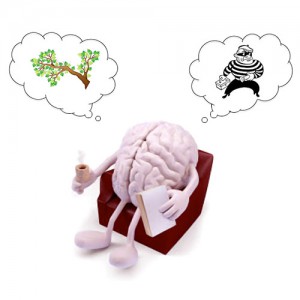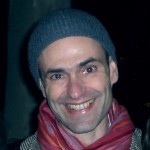Imagine this scene: it is a cold winter night and you are sitting in your favorite armchair reading an engrossing novel, a warm cup of tea by your side. Suddenly, a sharp noise rips through the silence. Now, freeze the frame here and let’s do a little phenomenology—what goes through your mind at that precise moment? If you are like most people, a potent and singular thought will have instantly and inescapably overtaken your mental space: “What was that?!” In no time, this question will also be followed by a few hypotheses about the cause of the noise (e.g., an intruder, or a branch falling on the roof), which in turn will prod you into a specific action aimed at determining which one of your guesses is true.
This example provides a simple introduction into a relatively novel view of how the brain works. The theory, broadly known as predictive coding, has been gaining increasing favor in cognitive neuroscience. From this perspective, the brain can be viewed as a “prediction machine,” constantly generating expectations about what the next batch of input stimuli should be, based on the current sensory data and the history of past experiences.

In the example, your expectation (and the brain’s neural prediction) is that your tranquil session of evening reading will proceed undisturbed; the loud noise represents a “prediction error,” which alerts the brain, and triggers it to generate hypotheses about the causes of the unexpected event. These hypotheses usually then prompt actions aimed towards gathering supporting evidence, such as running to the front door to see whether it has been forced or, alternatively, going upstairs to check for evidence of roof damage from a fallen branch. Furthermore, your tendency to believe one explanation or the other is influenced by your prior knowledge—prior to, or independent of, that specific event. For instance, if there has been a recent string of break-ins in the neighborhood, you will likely give more weight to the hypothesis of an intruder, whereas if the weather was very stormy, a branch on the roof might seem more plausible.
The predictive coding framework proposes that the bread and butter of the brain’s business is this iterative, inferential process of establishing the most likely cause for incoming sensory data, given prior knowledge about the probability of such causes. These predictions are woven continuously into what could be called a “model” of the world. Note that in this theory, which turns the classical view on its head, sensory input is not the leading actor in determining perception—instead, it takes the more supportive role of providing a corrective measure in the anticipatory guessing game continuously created by the brain.
At a physical level, the complex, multi-level architecture of the brain is ideal for creating such a probability-based representation of causality in the world. In time, the statistical regularities that define an organism’s environment come to be embedded within (or embodied by) the organism itself as an “internal model.” This internal model is nothing other than the functional structure of the organism and, in this sense, the organism is (rather than has) a model of its world.
To Revise or Confirm?
These ideas have recently been integrated by Karl Friston at University College London under a more general framework known as the free-energy principle. The principle is a mathematical formulation of the tendency of biological systems to resist disorder, thus maintaining their internal states within a viable range. Disorder is resisted by minimizing the disagreement between predictions and sensory data over the long term, a strategy that enables the system to avoid states that are too surprising and therefore disruptive to homeostasis. Organisms achieve this by balancing two main strategies: 1) adapting their predictions to reflect changes in the environment, and 2) seeking out those situations in the world that confirm and preserve their predictions. Put another way, the first option is to adjust or update your model of the world (your beliefs and perceptions) when faced with incompatible evidence—let’s call this the REVISE mode. Alternatively, you can actively pursue evidence that supports your existing beliefs and predictions—let’s call this the CONFIRM mode. Both are necessary for an organism to be well-adapted to its environment, and each of us performs a continual dance between these two approaches as we move through our worlds.
As the web of causal interactions in the organism’s world becomes reflected (through genetics and learning) in the web-like networks of the brain, the resulting neural system must resist disruption in order to carry out the higher-order biological imperative of the organism’s self-preservation. We could thus say that biological organisms are characterized by a constant struggle to validate their model of the world. As outlined above, this goal is met by adjusting perception and action so to minimize any discrepancy between the sensory input predicted by the model and the actual sensory information. Under the REVISE strategy, the discrepancy is “explained away” by changing the state and parameters of the internal model so that the updated prediction provides a better match to the current sensory data. Under the CONFIRM strategy, the discrepancy is reduced by leaving the prediction untouched and altering the sensory input by acting in the world so as to be exposed to stimuli that will best align with our prediction. Either way, the end result is that the system minimizes the discrepancy between its internal model and environmental stimuli. It does this by suppressing an information-based quantity called free-energy (generally equivalent to prediction error); thus, this whole process is known as “free-energy minimization” (FEM).
This view of brain function resonates strongly with the theory of autopoiesis proposed by Francisco Varela and Humberto Maturana some 40 years ago. Autopoiesis, meaning “auto-creation,” refers to the peculiar self-sustaining property of living systems, which are viewed as networks of processes constantly maintaining and recreating the conditions that allow them to persist in the face of a changing environment. More specifically, according to this theory, the essence of cognitive activity lies in the ongoing accommodation of the perturbations that threaten the self-organizing process (and thus the identity) of the organism. This idea ties in beautifully with the notion of cognition we see in predictive coding—as a process geared towards the reduction of a discrepancy between the predictions of the internal model and the reality-check provided by the world. Crucially, the free-energy principle is not only in agreement with Maturana and Varela’s original proposal, but adds a level of formalization that looks both neurobiologically plausible and mathematically tractable.
Prediction and Transformation in Contemplative Practice
These theories all rest on the idea that our everyday behavior is largely guided by our a priori expectations, often resulting in a form of autobiographically-based self-fulfilling prophecy. In other words, we tend to seek out precisely those situations that can further confirm our pre-existing ideas and habits. This may sound familiar to practitioners and scholars of contemplative traditions, which often expose and examine this tendency. Even though, as a rule, we should be wary of establishing simplistic parallels between such different epistemological domains, a few nodes of potential convergence between scientific and Buddhist contemplative frameworks in particular are worth mentioning.
The notion of karma (past behavior that biases the trajectory of our current perceptions and actions) aligns quite naturally with the role of prior knowledge in predictive coding. Buddhism also claims a fundamental non-substantiality and impermanence of the self (anitya), along with the suffering generated by the difficulty of dealing properly with it (duhkha). These ideas mirror the FEM notion that the identity of a living being (determined by its internal model) has to be constantly re-instantiated, and that this incessant struggle for self-confirmation may be phenomenologically linked to an undercurrent of anxiety, whether we are aware of it or not, that such confirmation may one day fail.
Most meditative techniques involve some form of attention regulation. Notably, attention is crucial in the FEM picture too, as a flexible mechanism for changing the relative weight (reliability) of the prediction error signals in the model. Importantly, attention is thought to mediate the rhythm of alternation between REVISE and CONFIRM modes—do we adjust our internal models (beliefs) to agree with our present experience, or do we actively seek out situations that validate our a priori models? What we attend to can determine which mode we employ.
The FEM view also has implications for understanding the transformation that may occur though contemplative practice. For example, many forms of meditation involve the adoption of a regulated bodily posture combined with physical stillness. The stillness of the seated posture together with the prescription of not becoming engrossed in spontaneous thoughts may induce a shift from the CONFIRM mode to the REVISE mode. When meditating, there can often be a discrepancy between the actual sensory signals arising in the moment and the predicted sensory signals cast ahead by expectations associated with spontaneous thoughts. For example, you may have the thought, “Oh—I need to write that important email I forgot about,” which would automatically generate a prediction of the sensory inflow corresponding to your getting up and going to your computer. If you weren’t meditating, your attention would probably be seized by this thought and thus the predicted sensory input would acquire a higher weight compared to the actual sensory signals. The latter would in fact appear to the system as lacking precision, and thus be deemed unreliable. In this case, the mandate to reduce the discrepancy between the predicted and actual sensory inputs (prediction error) would urge you into performing the predicted action—getting up and going to your computer (CONFIRM mode). In contrast, during sitting meditation, the prescription of immobility along with the heightened attention to sensory signals increases the weight of the actual sensory input over the sensory predictions triggered by the spontaneous thought. In this case, the discrepancy between predicted and actual sensory data will be reduced by adjusting the internal model (REVISE mode) so that the next prediction will be a closer match to the current situation—continuing to sit.
It is also possible that such model revision, by occurring at multiple levels of its hierarchical structure, also enhances the overall internal consistency of the model, which may in turn promote more globally coherent behavior in the long term. Seen from this theoretical angle, the regular practice of meditation may represent a beneficial antidote to the self-confirmation behavior (CONFIRM mode) that tends to prevail during daily life, helping to re-establish a more effective balance between model revision and model confirmation.
Considering these theoretical alignments, FEM looks to be a promising conceptual framework for the scientific investigation of contemplative practices. Dogen Kigen, the Japanese Zen Soto school patriarch, wrote in the XIII century: “Never foolishly misconstrue dim-sightedness as falsehood and thereby look for truth outside it. That is a short-sighted view. Because enlightenment is rooted in dim-sightedness, all things that constitute enlightenment are invariably the ones adorned with the dim-sightedness. Because delusion is also rooted in dim-sightedness, all things that constitute delusion are invariably adorned with the dim-sightedness as well.”
It is indeed fascinating that the intimate relationship between delusion and enlightenment finds such a fitting parallel in the FEM notion that a single predictive process underlies both “illusory” and “correct” perceptions. Illusory percepts are just as optimal interpretations of the world as correct ones, in the sense that they optimally integrate a priori knowledge and current sensory data. Illusions only emerge when strong a priori beliefs meet with sensory input that is ambiguous, thus allowing the beliefs to take the driver’s seat, as it were, in determining our perception. Illusion is therefore built into the very mechanism that allows us to know something about the world. Stated more positively, our vulnerability to delusions may be nothing other than our very opportunity for realization.



